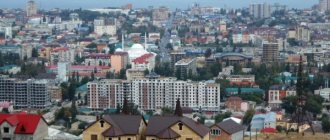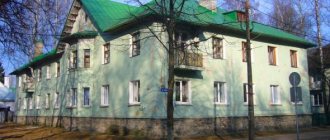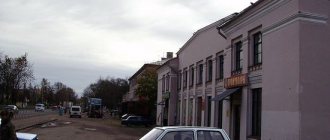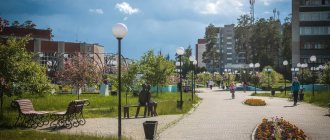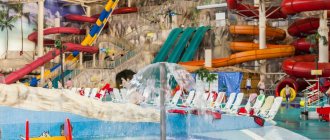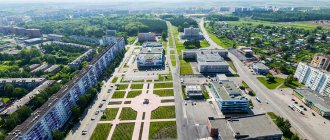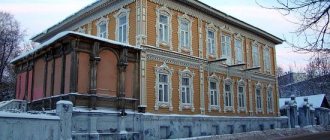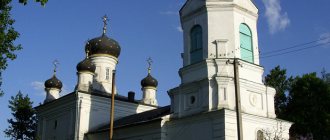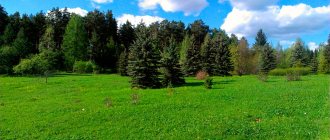They say there is nothing to see in Pionerskoye except the sea. Yes, if you don't know where to look. The analogy between a meat dish and a vegetarian dish comes to mind. Every second person will create a hearty and edible menu using meat, but you have to try to cook it nutritiously and tasty without meat. Svetlogorsk and Zelenogradsk are the “meat” of the Baltic Sea resorts, and Pionersky is the sabji. Pionersky teaches you to notice details. Most of the “details” are on Komsomolskaya Street. We will follow it, starting from the railway station.
Residential building on Komsomolskaya
Features of recreation in Pionersky
The mild climatic conditions of the area are favorable for those who suffer from sudden temperature changes. It is neither cold nor hot here, and the air is saturated with sea freshness and oxygen. In addition to the pine forest on the coast, there are a lot of green spaces in the vicinity of the city. There are wide sandy and sand-pebble beaches.
It is convenient to walk on the coast along a clean and equipped promenade or along a pier that goes 200 meters into the sea. They were also chosen by athletes - runners, cyclists and fishermen. In the summer season, the city is transformed by a riot of floral colors in flower beds and umbrellas of open-air cafes. The serene faces of those around you also create a resort mood. Here you can rent housing for a relatively low cost.
The sights of the city are not visible at first glance. Only by calmly walking along Pionersky can you discover ancient streets and houses, well-groomed squares and parks, equipped walking paths and, of course, sea views.
Location
The city of Pionersky is located on the shores of the Baltic Sea, not far from Svetlogorsk (about 5 kilometers). So close that one day in December we even walked from Pionersky to Svetlogorsk; you can read about this walk in the corresponding article.
Pionersky itself is quite small. Officially, 11.3 thousand people live in Pionersky (statistics as of January 1, 2018). The city's population has been gradually decreasing since 2014. An interesting difference from neighboring Svetlogorsk. An interesting fact: in 2014, more residents lived in Pionersky than in Svetlogorsk.
Before the Second World War, there was a quiet and calm German resort town of Neukuren (emphasis on the “u”). It is in Pionersky that one of the government residences, or as they sometimes say, the presidential dacha, is located. From the shore, from a pine forest or from the road, everything is clearly visible.
Pionersky is located in a small bay of the Baltic Sea with a sandy beach. This probably creates a special microclimate. The air here is light, and the town itself seems calm and in no hurry.
Streets of Pionersky
History of Pionersky
The appearance of Pionersky dates back to 1254
- it was then that the first mention of it appeared in the chronicles of the Teutonic Order.
In those days it was the fishing village of Rantau
(Rantava). Today it has become the village of Zaostrovye, part of the city of Pionersky.
However, people settled in this region much earlier. The development of local lands by the ancient Prussians began in the 2nd century. BC. Ancient burial mounds of that era are of constant interest to scientists. And the local marine industries of collecting amber and fishing are traditional, with a centuries-old history.
View of the village from above
For thousands of years, Rantava was a fishing seaside village, until humanity came up with the idea of healing and relaxing at sea. So, in the 19th century in the Baltic, the Prussian city of Kranz (modern Zelenogradsk) was transformed into the first resort. Here they began to develop the tourism business, creating the appropriate infrastructure (hotels, catering outlets, beaches, etc.).
Soon the residents of Königsberg discovered the surroundings of Rantava, coming here with whole families for picnics. In 1837, not far from the village, the first 4 balneological buildings were built for vacationers. This is how the New Resort (German: Noikuren) appeared - Neukuren
.
Neukuren's popularity increased dramatically when a railway connection to Königsberg was built in 1899. The fast and comfortable route to the holiday destination attracted a large number of new tourists. In 1910, a modern kurhaus appeared in the village. This was the name of the largest and main hotel in the area. In addition to the rooms, here you could visit a restaurant and baths, play billiards and admire the Baltic inhabitants in aquariums. Subsequently, it was transformed into a sanatorium for children's recreation "Pionersk".
Holidays in Neukuren in the 19th century
New cottages and villas were built from the railway station to the coast - they were rented by vacationers. During the holiday season, there were up to 5 thousand visitors to Neukuren. At the beginning of the 20th century, 15 large breakwaters (groins) were built on the coast. Thus, the width of the beach reached one hundred meters, becoming the largest on the Prussian Baltic coast.
In parallel with the development of the resort business, fishing was maintained in the village. In 1935, the Nazis built an airport between Neukuren and Rantau. The resort housed a flight school and a military aviation regiment. Erich Hartmann trained here, becoming the best pilot of Nazi Germany. In Neukuren, also during the war, there was a women's department of the intelligence school, where they taught espionage in the Russian rear.
Our troops took Neukuren in mid-April 1945. The buildings of the settlement were not seriously damaged during the battle, since there were no capital defensive structures here. At the end of 1946, the Kurhaus became the Pionersk children's sanatorium, subordinate to the Ministry of Health of the RSFSR. This is where the name of the city came from. In the summer of 1947, Neukuren was officially transformed into Pionersky, giving it the status of a “resort village.” In 1952, taking into account the significant development of the economic sphere and population growth, Pionersky received city status.
Nowadays, despite the fact that the sanatorium is located in a former Kurhaus, its original appearance has been radically changed. As a result of numerous reconstructions, the building acquired a modern appearance. Images of the Kurhaus remained on old postcards.
Kurhaus at the beginning of the 20th century
Today, the main city enterprise is a fish processing base, operating since 1947. In the 1970s it was the largest unit of the Soviet fishing industry, numbering 90 vessels that annually produced up to 200 thousand tons of fish from the Baltic Sea and the Atlantic Ocean. In post-perestroika times, the enterprise was reorganized into several small private companies. Currently, the basis of the city's economy is still fishing and its processing.
Transport and how to get there
From Kaliningrad to the city of Pionersky it is just over 40 kilometers; travel time on a free highway can literally take about half an hour or 40 minutes. There is also a railway station in the city and electric trains run to Kaliningrad. Pionersky is also connected to neighboring cities by bus and train services.
Accordingly, there are three options to get to Pionersky: by rail, by bus or by car. The schedule for all types of transport can be checked with the bot in the telegram @KenigGuidebot.
Railway
You can get there by electric train from the Northern and Southern stations of Kaliningrad.
The schedule can also be checked with the bot in the telegram @KenigGuidebot, on the website of the Kaliningrad Suburban Passenger Company or on the official website of Russian Railways. In addition to Kaliningrad, Pionersky is also connected by rail with Zelenogradsk and Svetlogorsk.
Bus service
Bus number 119 runs quite regularly from Kaliningrad to Pionersky. The final stop in Kaliningrad is the South Station, and in Pionersky the railway station. In Kaliningrad, the bus route goes through the city and stops in the center at the stops "Hotel Kaliningrad" and "Northern Station".
Buses run quite regularly according to the schedule (you can check it with the telegram bot @KenigGuidebot or on the bus station website).
You need to keep in mind that on weekends and especially during the season, transport can be very busy (a large number of people want to go to the sea). Accordingly, if you travel by bus or electric train, you may end up in a situation where you have to travel while standing.
And in a separate article, read how to get to Kaliningrad from greater Russia.
Car or taxi
If you rent a car or a taxi, then the question of how to get there comes down to choosing the route. That is, across the highway to Zelenogradsk and past Kulikovo, or through Pereyaslavskoye, like bus 119.
The cost needs to be clarified. There are federal taxi operators, so there is a choice.
Baltika, seagulls, Pionersky
Climate and ecology in Pionersky
The climate is temperate, transitional from temperate maritime to temperate continental. The seasons of the year are well defined. Spring and autumn seasons are pronounced, with mild winters (mostly without severe frosts) and relatively cool summers (sometimes hot weather). Due to the proximity of the sea, the air is quite humid.
Average air temperatures correspond to climatic data for Kaliningrad. Overall moderately warm. In summer the swimming season opens.
Swimming season in Pionersky
Swimming in the Baltic Sea is usually comfortable from July to the end of August. In September the water may be warmer than in June. The warmest water is in August (warms up to 18° Celsius). It can be higher (depending on summer).
Attractions
There are several natural and man-made objects in Pionersky that attract the attention of tourists.
Beach in Pionersky
Park complex "Sosnovy Bor"
Sosnovy Bor is located along the sea coast, within the city limits - from Gvardeysky Cape
to the neighboring village of Zaostrovye. Even before the Great Patriotic War, this picturesque natural area was a landscaped recreation area for citizens and tourists. Here, in the shade of pine trees, you can enjoy the fresh healthy air, listen to bird trills, treat the squirrels with nuts, or just sit with a cup of coffee in a forest cafe. From here you can go down to the promenade and the sea.
A picturesque park on the Baltic coast
Today, the Sosnovy Bor park area is a comfortable vacation spot. Additional greenery has been planted here, new walking paths have been created, playgrounds for children and sports grounds have been installed. The arrangement of park benches allows you to watch the sea. In winter people go ice skating and skiing here.
Boulders
In the vicinity of the city there are two natural boulders that have given rise to beliefs and legends.
The most popular is the Stone of Lies - a large boulder as tall as a man, divided in half. The distance between its parts is sufficient for a person to pass through.
Mysterious boulders
There is an ancient legend associated with the stone. Allegedly, one day a young fisherman, before going out to sea, brought his beloved to a boulder, the parts of which could not be connected. The young people swore mutual fidelity, and the fisherman set off on a sea voyage. He returned after a long time, and with a good catch. The proceeds were enough for the wedding. He again brought his girlfriend to the boulder. When the beloved entered the crevice of the stone, lightning struck it, connecting it and absorbing the unfortunate woman. Thus, heaven punished her for her infidelity. Hence the belief that a liar will not be able to pass through the crevice without problems.
The second famous boulder, mentioned in pre-war guidebooks, is the “Cheek” stone. It was given a name, like the Stone of Lies, a long time ago. This boulder is larger than the first and is located near Cape Kupalny, in the Gorge of Roses. It can be seen to the right of the path to the sea when descending.
Temple of the Tikhvin Icon of the Mother of God
During the Soviet period in Russia, Orthodox buildings were not built. The Temple of the Tikhvin Icon was built in Pionerskoye already in the current millennium. Until construction was completed, services were held in a building that previously belonged to the radio station.
Temple of the Tikhvin Icon
In 2013, the main construction work on the construction of the temple was completed, opening access to it for parishioners. Tourists and believers are attracted here by the richly decorated iconostasis and beautiful landscape design on the territory of the temple.
Residence of the Government of the Russian Federation "Yantar"
In the 19th century, on the site of the government residence "Yantar" stood Bismarck's dacha
- famous German chancellor. In the 30s In the last century, it was converted into the barracks of a German flight school and air base. And later, until the beginning of the “perestroika” period of the 90s, the Soviet military were stationed here.
Subsequently, one of the barracks was given over to a secondary school, and some of the buildings were rented by aspiring entrepreneurs. However, most of the buildings in the complex were empty and gradually destroyed until the Russian government decided to build a residence on this site.
Yantar - government residence
The four-story building was opened in the summer of 2011. The Prussian “Northern Art Nouveau” style gives it a respectable and solid appearance. In addition to luxury apartments, there are rooms for press conferences and receptions, banquets, a bar, a kitchen and a buffet.
The residence also has the most modern health and treatment equipment - solariums, jacuzzi, hydromassage showers, Turkish and Russian baths, sauna with ice water. There are areas for sports: a swimming pool, tennis courts, football and basketball fields. The territory is decorated with a pond with carp and trout, replenished from an artesian spring.
The building is always ready to receive dignitaries, but most of the time it is empty. Dm visited the residence only twice. Medvedev, and S. Lavrov held negotiations with foreign diplomats here once. Therefore, there are opinions about repurposing the residence into a VIP-class hotel. Everyone will be able to appreciate government luxury and comfort.
Rantava Museum
The Rantava Museum was opened in 1992. Its exhibition is based on the finds of Soviet archaeologists from 1987–1992. At that time, they were exploring the large Prussian burial complex “Mountain of Giants,” dating from the 3rd–9th centuries. AD Here visitors can view artifacts from the rise of the Roman Empire and the Amber Road.
Museum exposition
There is also a collection of materials testifying to the history of Neukuren. A separate exhibition is dedicated to the city fish processing enterprise - its history and workers. The city museum demonstrates the stages of development of Pionersky from ancient to modern times.
Mass grave with memorial
The monument to the mass grave, where Soviet soldiers who died during the Second World War were buried, was erected in 1950. In 1971, a memorial complex was built here, which underwent reconstruction in 2010. 180 people are buried here, whose names are engraved on memorial plaques.
Photo of the memorial
Monument to sailors
Next to the Rantava Museum there is a memorial composition erected in honor of the sailors. It is a boulder with a metal plaque commemorating their exploits. On both sides of the boulder there are stone pedestals on which anchors are depicted.
Monument to the glory of sailors
Monument to Baltic aviators
The memorial was erected in 2015 in honor of the Russian Baltic Air Force. Its units were in the city after the war. In the center of the monument is a diving Il-2 attack aircraft. In front of him is a granite slab with memorable words.
Monument to aircraft builders
Monument to the fisherman
In the fishing town there are two monuments dedicated to this profession - on the street. Parkovaya and at the intersection of st. Shamanova and Vokzalnaya.
Monument to fishermen
Monument to participants of local wars
Near the administrative building there is a boulder dedicated to participants in local wars. The stone bas-relief is installed on a pedestal and decorated with a commemorative plaque.
Let's return to Komsomolskaya and approach the post office building (Komsomolskaya St., 15). To the right of the post office is an old house, the sign on which says that the building was built at the beginning of the 20th century. Under the Germans, there was a post office here, and ten years ago there was a telephone center, amber shops and a Rostelecom office. Rostelecom lasted the longest, but in 2016 it was replaced by a beer establishment, the owners of which for some reason considered it acceptable to decorate a historical building with a vulgar picture of a cheap glass. But why be surprised? A disaster on a regional scale is the bad taste created by local small entrepreneurs.
Post office building
